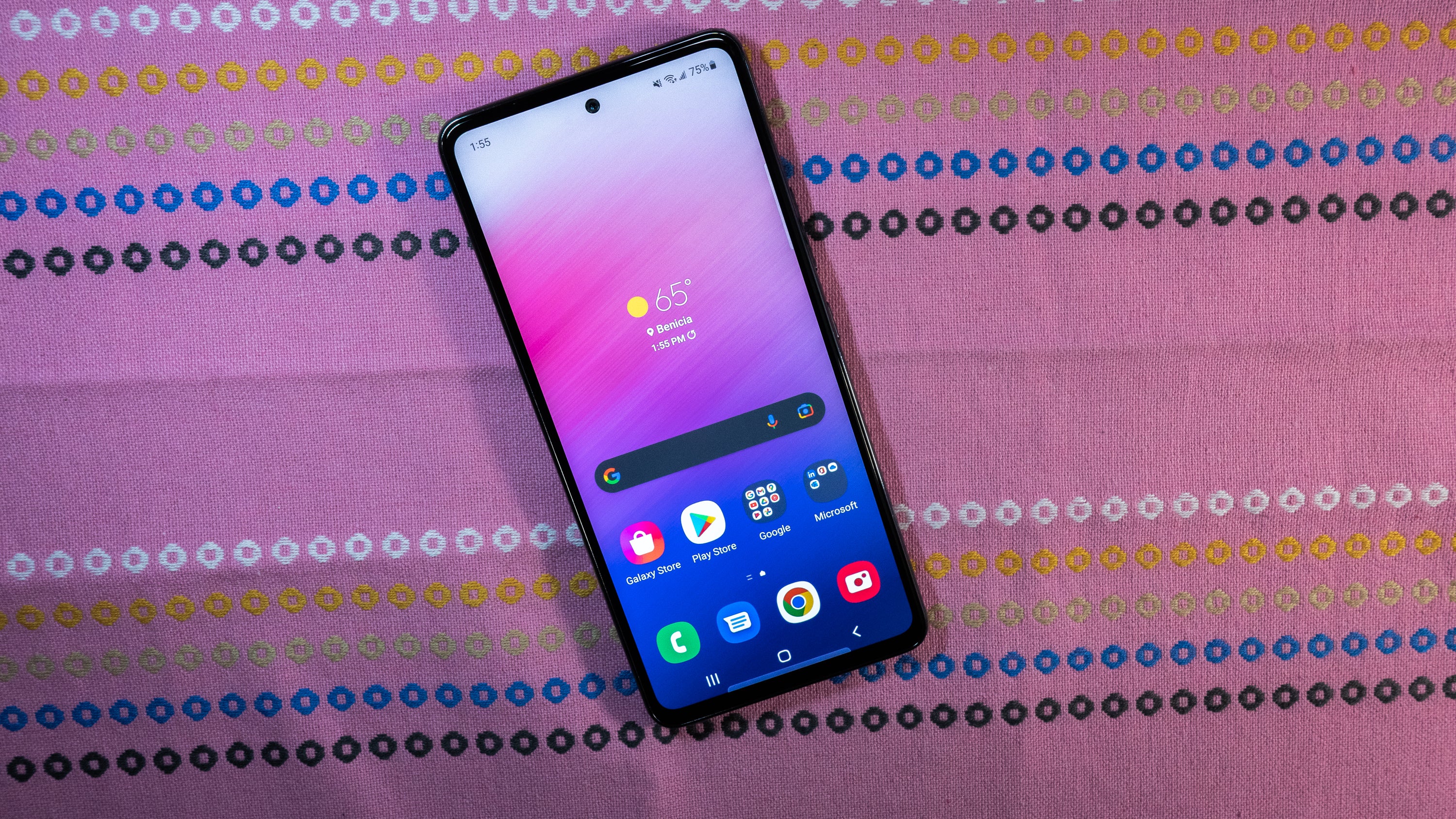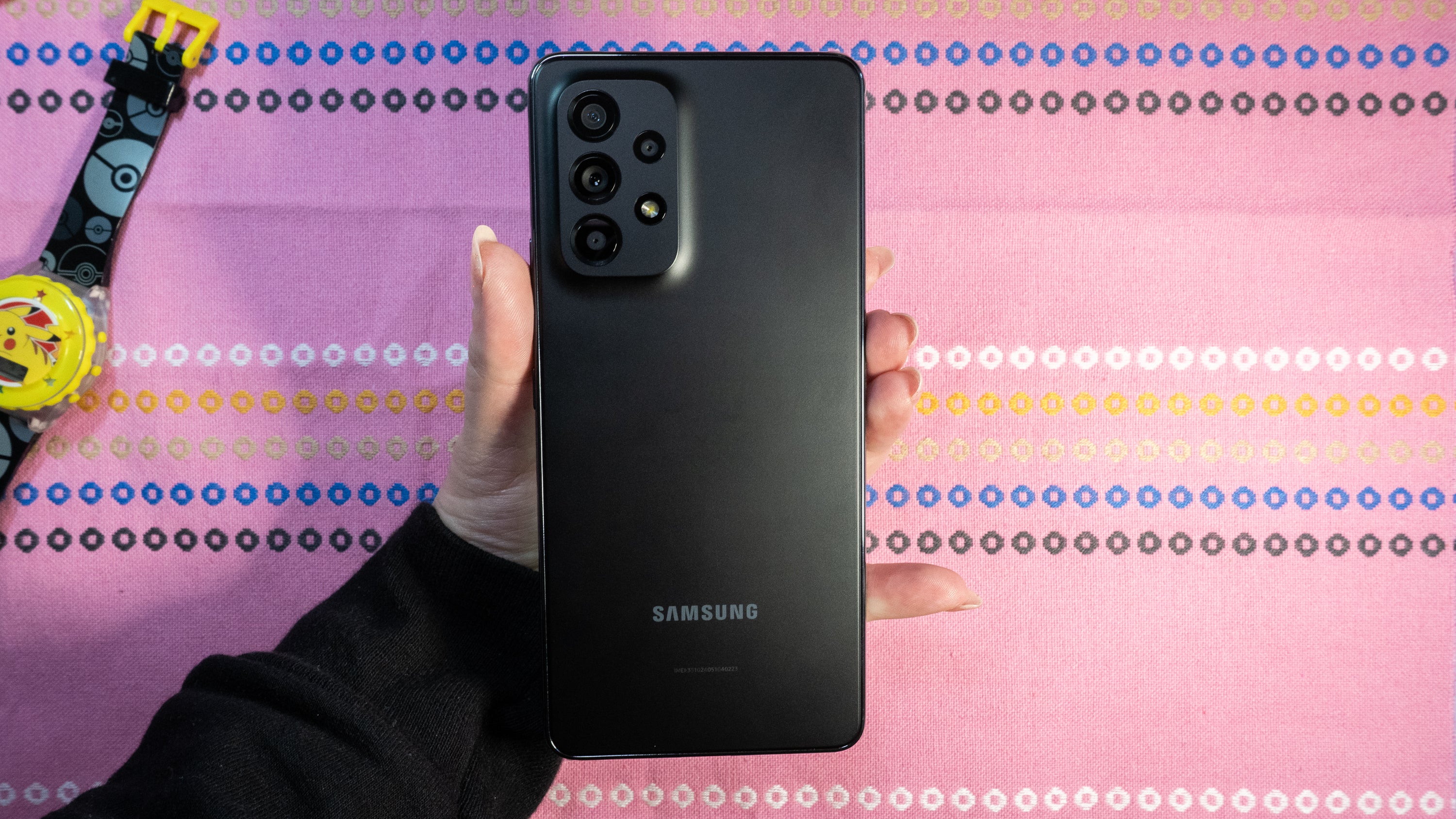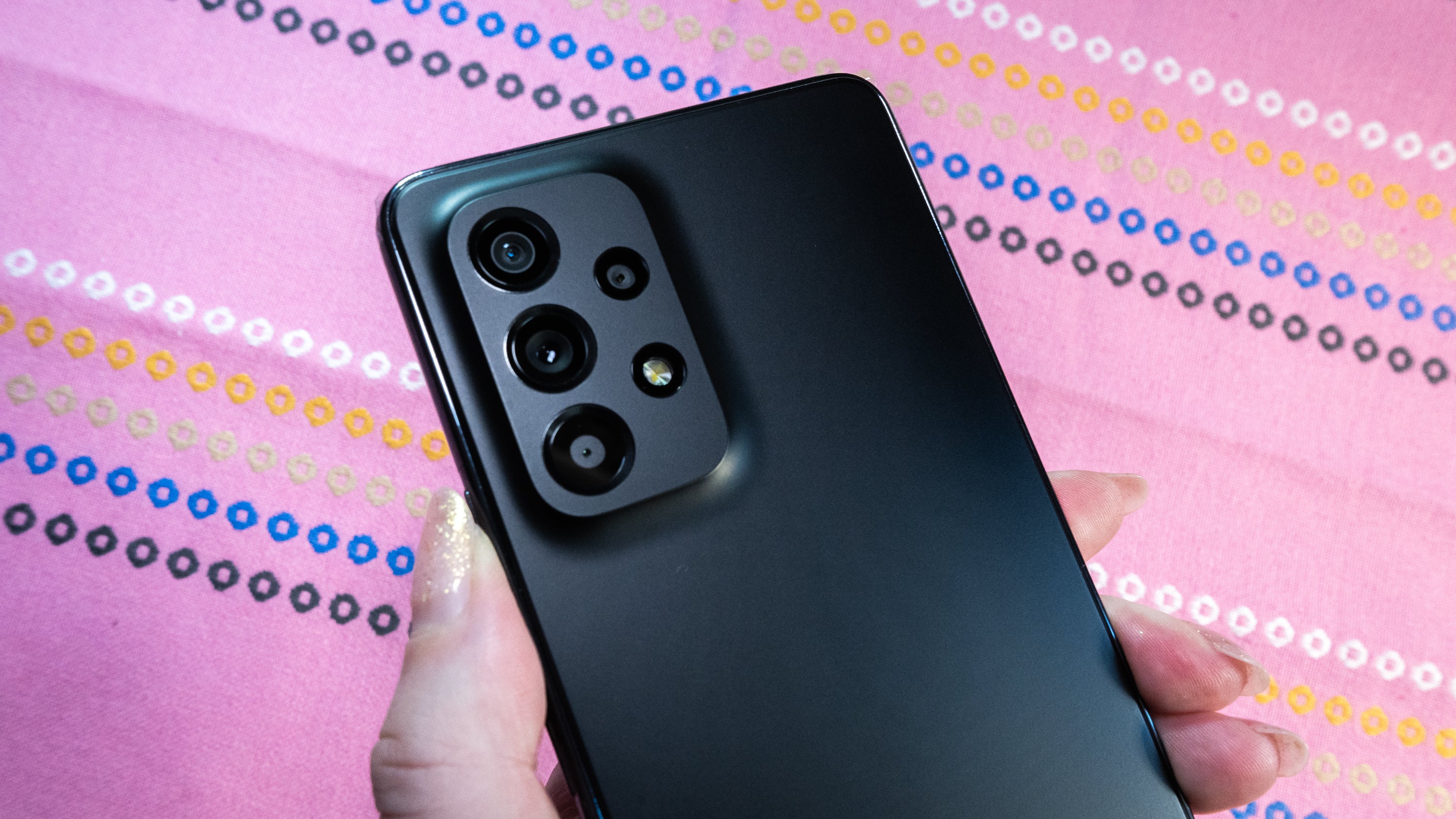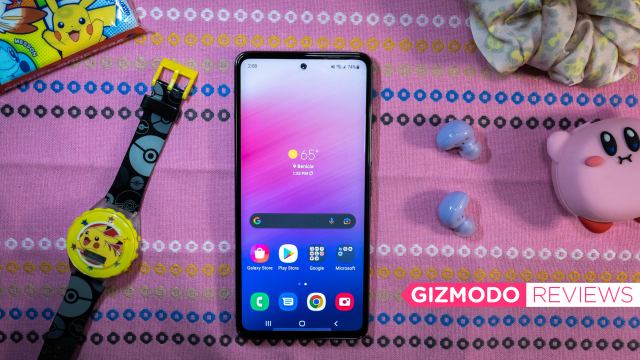Mid-range smartphones are having a moment. Every major brand that considers itself a worthy player in today’s smartphone wars has to have an affordable equivalent to its flashy flagship. For Google, it’s the Pixel 5a — soon to be Pixel 6a, if rumours are true. For Apple, the iPhone SE nets you the same silicon as the iPhone 13. And for Samsung, it’s the Galaxy A53, which can’t match the performance of its flagship sibling but still understands what makes Samsung devices great.
And that’s fine. It’s normal to temper your expectations if you’re going for a mid-ranger, and the Galaxy A53 really knocks it out of the park with Samsung’s unique strengths. It’s got a vibrant display with a flagship-grade refresh rate, a camera system with all the lenses you could need, and the latest version of Android, chockful of Samsung flavoring. Also, we love that long battery life, and you can be sure this phone is going to get plenty of software support for the foreseeable future.
Since this is a sub-$699 device, there are, of course, concessions to make. This isn’t Samsung’s best-designed smartphone, nor is it the most capable. But if you want to stick with Samsung and you’re on a budget, the Galaxy A53 is a pretty good deal.

Samsung Galaxy A53 5G
What is it?
Samsung's latest mid-range smartphone
Price?
$699
Like
Long battery life, long software update life, it's like carrying a little Samsung TV in your pocket
Dislike
Cameras are fine but not the best in low-light, onboard storage is limited unless you get an SD card, it's quite clear at times you're using a mid-range device and not a flagship one
Not much has changed

The Galaxy A53’s look hasn’t changed from its predecessor, the Galaxy A52, though that’s par for the course with mid-range devices. (Case in point: the iPhone SE has looked the same for two generations.) It would be nice to see Samsung try something a little more premium with the A-series. Samsung sent us the A53 in black, and that’s currently the only option available for purchase. The A53 comes in four colours in other markets, including white, peachy pink, and a cute baby blue.
The Galaxy A53’s backside remains relatively unchanged from the A52. There are three main camera lenses: a primary 64-MP camera with optical image stabilisation (OIS), a 12-MP ultrawide camera, and a 5-MP macro camera. There is also a 5-MP depth sensor. I’ll get more into the rear-facing camera system and how it performs later.
The Galaxy A53 sports a 6.5-inch Super AMOLED display with bright, saturated colours and a 120Hz refresh rate, an excellent flagship-level spec to include in this product range. The A53 is primed for watching videos or scrolling endlessly through TikTok. The smoothness of the picture is like carrying a tiny Samsung TV in your pocket. Like the Galaxy S22 series, Samsung does offer a super high brightness mode for reading out in the sun, up to a maximum of 800 nits, but only if it detects sunlight. Otherwise, the maximum brightness is about 416 nits.
The Galaxy A53 is only available with 128GB of storage if you buy it in the U.S., though there is a microSD card slot slyly embedded into the SIM tray so you can add storage for video and anything else you might need it for. I’d also like to offer a PSA to bring your own smartphone charger and cable, as Samsung doesn’t include either with the purchase of the Galaxy A53. It’s for the environment!

The Galaxy A53 offers some flagship-level security features. Face Unlock is available, and there’s also an under-display fingerprint reader. Both of the unlocking mechanisms work fine.
An improvement in battery life
This year’s Galaxy A53 strays from the routine upgrade path of using Qualcomm’s latest mid-range chip. Instead, Samsung’s back to using its homegrown processor, the 5nm Exynos 1280. It’s an octa-core chip with a Mali-G68 GPU powering it up, which bodes well if you’re the person to keep Pokémon Go open all day waiting to join a five-star Raid. It’s coupled with 6GB of RAM, though the phone is also available with the option of 4 and 8GB of RAM in other markets.
Performance-wise, the Galaxy A53’s Exynos processor was on par with last year’s Pixel 5a, which runs on a Qualcomm Snapdragon 765G. It only performed two points better on Geekbench (1803) than one of this phone’s related devices, the Galaxy Tab S7 FE, a tablet with a Snapdragon 750G processor (1801). Geekbench is a synthetic test, so it isn’t a perfect comparison to anecdotal use, but it gives us a better understanding of how a chip stacks up to what’s already out there. For you nerds out there, we ran the single core test.
Predictably, the A53 was much slower than the current crop of flagship Android phones, though its Web XPRT 2015 results were on par with the Pixel 5a and TCL 20 Pro, which shows it’s a solid mid-ranger.
Despite the solid benchmark numbers, there were a few times when I remembered I was using a mid-range device, particularly when I was switching between photography and video modes. Thankfully, I didn’t feel it while playing Pokémon Go, except in the cases where I was in a busy area with lots of Pokémon sprouting around me. But that can lag the game even on the most powerful flagship devices. The fingerprint scanner is also not as lightning quick as on the now-ageing OnePlus 9, which I’m currently using as my daily driver.
Where the Galaxy A53 shines is in its battery life. Samsung outfitted this particular device with a 5000 mAh battery, and it impressed me from the moment I set up the phone. The Galaxy A53 managed 18 hours and 30 minutes of video playback before petering out. It outlasted the OnePlus 10 Pro, Motorola Edge+, Xiaomi 12 Pro, and even its flagship counterparts in our battery rundown test, which entails streaming a 24-hour video from YouTube at exactly 200 nits, just above the midpoint on the brightness slider. It even outlasted the Galaxy S22 Ultra, which isn’t a major surprise considering that device’s larger screen and more intensive processor. However, the A53’s results were on par with the Google Pixel 5a’s, which has a smaller 4680 mAh battery, indicating potential room for improvement in fully utilising what this phone packs. Still, this is a minor quibble, and the display on the Pixel 5a has a lower refresh rate and doesn’t draw as much power. Anyway, it’s good to know you can find stellar battery life under the $699 price point.
Cameras for everyday capture

I’m impressed by how far smartphone cameras have come in the past five years, and the Galaxy A53 only lags behind the trend a little thanks to its budget status.
The Galaxy A53’s camera system is similar to its predecessor’s, down to the 64-megapixel camera with an f/1.8 aperture and wide field of view. As I mentioned earlier, it does have OIS, which helps stabilise the camera as you’re moving the phone to sharpen shots regardless of the environment. The aperture also allows the lens to take in more light for software processing.

I like the daytime photos I took with the Galaxy A53 well enough. I spent a sunny day at the beach, and the images came out clear and well-saturated. The blue in the sky does appear like it was cranked up in Photoshop, but I appreciate that on a mobile device’s camera, because it helps when taking the photo to social media. The A53 is also capable of portrait and wide-angle shots, though the latter will introduce the same distortion you’d see on any lens with a 123-degree field-of-view.
If you’re not shooting on a sunny day, Samsung’s saturation engine turns up the contrast, making scenes appear dark and dreary instead of neutral and grey. That was especially apparent as I shot photos with different zoom rates on the A53 during a rare rainy California day. As an aside, there is no telephoto lens, so while you’re getting capable zoom, it’s hardly as sharp as what you’d get paying nearly three times as much for the Galaxy S22 Ultra. Still, the 3x optical zoom helps for framing when shooting up close.

Selfies taken with the A53’s 32-MP lens looked great, and I was not shy about using it. My kid and I especially enjoyed the integrated Snapchat filters available inside the Samsung camera app. No sign-in is required.
The Galaxy A53 can record video at a maximum of 4K and 30 frames-per-second (fps). By default, it shoots at 1080p at 30 fps, though you can bump 1080p recording up to 60 fps if you want. Videos can be particularly sharp on a sunny day, and it helps that Samsung’s tracking algorithm remains steady as you’re panning around a scene even with the stabilisation option off. I did not regret taking videos of my child with the A53.

Unfortunately, I do not have the Google Pixel 5a to make a side-by-side camera performance comparison. However, you are likely to have a better time taking low-light shots with Pixel 5a than you would the Galaxy A53, simply because we have several generations of evidence that it’s where Google succeeds with its mid-range hardware.
Flagship-level features throughout
When I say “flagship-level features,” I don’t just mean the hardware. I am also alluding to the software and Samsung’s attempt at parity across devices. The A53 will get four years of Android platform updates plus five years of security updates. That’s a little longer than what the Google Pixel 5a will get if you buy it right now. And while it’s likely that you won’t be getting software updates as consistently as everyone else towards the end of the A53’s tenure, it’s reassuring knowing Samsung will have your device in mind for a while.
One concession to keep in mind with this device is that Samsung requires you to log in to a Samsung account to get creative with the interface — particularly if you’re keen on downloading themes and icon packs from the Galaxy Apps store. You still have access to everything Google gives you through the Play Store, but there are some gems you can only find through Samsung. Anyway, if you’re planning to enter the Samsung ecosystem through accessories like a pair of Galaxy Buds and the Galaxy Watch 4, you’ll have to sign up for and tend to a Samsung account if you want to backup your settings and things of that sort. This is one of the drawbacks of choosing an Android device not made by Google.

There is a big difference between the $999 base-model Pixel 6, which lauds its tried-and-true camera system, and the $699 Samsung Galaxy A53. It’s not just the premium specs — Pixel 6 ships with 8GB by default — or the design differences (the A53 in black is boring!). That $300 price cut could be a lifesaver for some. The good news is that the Samsung Galaxy A53 won’t make you feel like you’re missing out on much, even with its mid-range specs.
